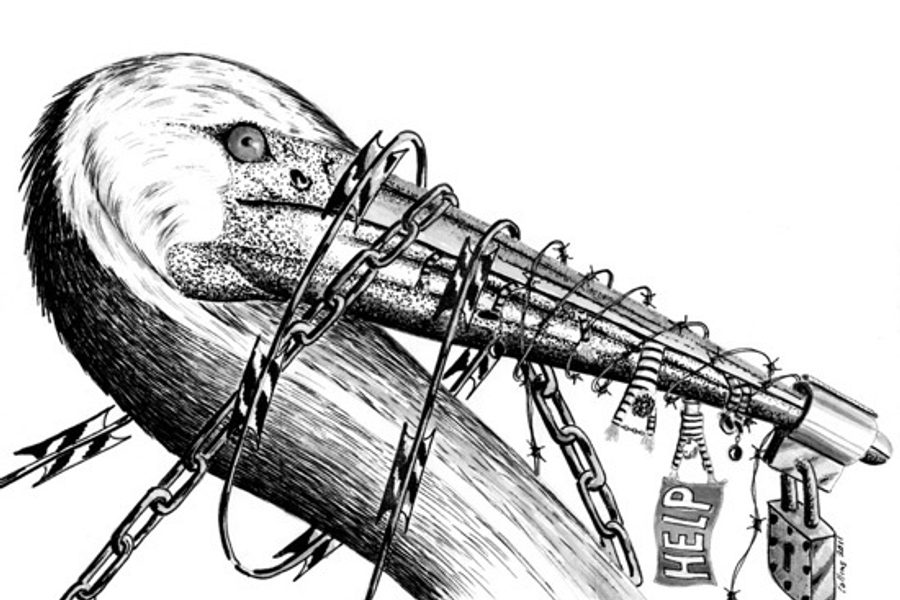Hunger Strike, Day 55: Each Minute ‘Extremely Taxing,’ Say Prisoners; Force-Feeding Feared
George Lavender

Fifty-five days into a hunger strike to protest long-term solitary confinement, prisoners at Pelican Bay State Prison in California say they are at “a critical stage.” In a joint statement, prisoners described each minute as “extremely taxing mentally and physically.” They say more than 50 strikers have been moved to a medical facility in preparation for what they believe will be an attempt to feed them against their will.
Force-feeding of prisoners has come under greater scrutiny since it emerged that the practice is regularly used on hunger-striking detainees at Guantanamo Bay. Pelican Bay prison healthcare officials deny that anyone will be forced to accept treatment, but a recent legal decision has raised concerns about force-feeding. Last week, a federal judge issued a court order allowing doctors to disregard signed requests from hunger-striking prisoners not to be resuscitated. Carol Strickman, an attorney with Legal Services for Prisoners with Children, explains that the order means “people who are unconscious or on the verge of death, who don’t want to have food administered to them, and have made that clear, could still have food administered to them.”
California Correctional Health Care Services spokesperson Joyce Hayhoe says the court order was sought because corrections officials were “concerned that there might be inmates who felt coerced” by other prisoners into signing statements opposing resuscitation. Officials maintain that the hunger strike is being organized by prison gangs, but advocates say there is little or no evidence of that. Hayhoe says she visited Corcoran State Prison, where prisoners are also striking, and found “a lot of prisoners there were very much in favor of the hunger strike,” but says she also spoke with two prisoners “who were either worried about receiving medical treatment or food because they did not want their cellmates to see.”
All this sounds familiar to Dr. Jacob Appel, a psychiatrist and lawyer at Mount Sinai hospital in New York, who has written widely about force-feeding of prisoners. Fear of coercion is regularly used as a “bogeyman” by prison authorities to justify force-feeding, he says. “Maintaining prison order” is also cited as a reason to ignore a prisoner’s desire not to be fed.
The American Medical Association and the World Medical Association both consider force-feeding to be a form of torture. In American prisons, Appel says, the standard procedure is to offer a prisoner the opportunity to end their hunger strike, if they choose not to, they are given the chance to consent to a nasogastric tube. After that, medical staff take a plastic tube and “shove it up your nose and down the back of your throat into your stomach, it’s a very bumpy process, and you sort of jab until you find the right holes”. Food is then pumped into the patient’s stomach. If the hunger striker resists then their arms and legs are strapped down. Appel calls the process “highly intrusive” but explains that all doctors are trained to perform the procedure on patients with a medical need, and who consent to it. Where he says it breaches medical ethics, is when the procedure is carried out on someone who has consciously refused to be fed.
As a medical student, Appel says, he had to administer a nasogastric tube to an unwilling patient — an experience he calls “the worst in my adult life.” Although the patient in that case had previously requested the procedure before “losing mental capacity,” he says the experience was still “horrific.” When he learned “that we were doing this [inside prisons] to people who have capacity and are competent and still don’t want it done,” he was “utterly horrified that doctors were taking part.”
“Most people, including most doctors, aren’t aware this even goes on in the United States,” he says. While the number of prisoners force-fed in prisons is not known, he estimates that “there are a handful of cases each year that go to trial or court, and probably a large number that don’t.” Doctors who take part in forced-feeding should be banned from practicing medicine, says Appel. “Doctors as a professional group should not just take a stand,” he says, “but refuse to professionally interact with doctors who do engage in this practice.”
Following criticism of the court order, prison healthcare officials have publicly downplayed the possibility of hunger strikers being force-fed. Officials say the order had been mischaracterized. “This is not a Guantanamo Bay situation at all,” says Hayhoe. Gastric tubes are “a possibility,” she says, but insists “it would be a case-by-case basis in which the doctor would determine what an inmate needs to stay alive.” A prisoner who consistently refused treatment would not be forced to accept it, said Hayhoe. More likely, she says, is that a hunger-striking prisoner who became unconscious might have an intravenous line inserted into them, to receive nutrition that way. The court order allows doctors to do that even if the prisoner has signed a declaration opposing any such treatment.
Hayhoe says her department is “very worried about inmates who have gone a long time without protein” which brings with it risks of “long term damage to your muscles, your internal organs, your eyesight” as well as the “threat of having an immediate cardiac arrest.” There are currently two prisoners who have lost more than 15 percent of their body weight, and another 12 who have lost more than 10 percent, she says, but “none have a body mass index we consider to be of concern.” However, she did say that some prisoners are refusing to be weighed.
Appel says that while re-feeding by intravenous fluid is “probably less unpleasant,” it is still “highly unethical, and doctors should not participate” if someone has previously stated their opposition to being resuscitated. “We do not invade the bodily integrity of people against their will,” he says. “We should do things to help patients, and we’re doing this to help prison order, at the expense of patients.”


